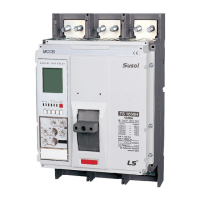50
M. Inspection and Troubleshooting
1. Inspection and replacement cycle
[Inspection method ]
Checklist Checklist Solution
1. Dust
■ Inspect for dust on the surface of circuit breaker, especially on
the top side of the switch and for dust stuck by oil etc.
■ Clear dust away with cleaner and dry, then
wipe with a clean cloth.
■ Use neutral detergent
(do not use corrosive detergent)
2. Loose
terminal
screw
■ Check if terminal screws or wire tightening screws etc, are
unscrewed or loose.
■ Use standard tools.
■ Depending on the material and the size of
screws, please tighten them with designated
tightening torque
3. Opening
and
closing
■ If the circuit breaker is closed at all times, move the switch off
and on many times to prevent a friction increase by grease
hardening.
■ Stabilize contact resistance with a small moving operation of the
contact.
■ If switch is not flexible, then request
replacement or repair.
4. Insulation
detail
■ Measure insulation resistance between each phase and ground
with a 500V insulation resistance meter.
■ Measure the outer side of conductor.
■ If it’s under 5㏁, you need to exchange it with
a new product as a rule and investigate why
resistance went down.
■ Inspection after breaking
If circuit breaker is broken by fault current, depending on the size of fault current, you can either reuse it
or replace it.
Size of breaking current Damage level of circuit breaker Solution
Operating range of instantaneous trip
(The current less than 10times of rated current)
No defects other than exhaust hole
Reusable
*Available to break the 6times of rated
current around 50times (less than 100A )
The circuit current which has a small value
relatively
The short circuit current near to rated breaking
capacity
The carbonization are shown
around exhaust hole
The carbonization around Handle
and exhaust hole
Welded metals inside circuit
breakers after tripping
Reusable
Replace with new product
1) Measure the insulation resistance of circuit breakers after removing it when it is unable to estimate
the value of faulty current.
2) Carry out dielectric test only in case insulation resistance is less than 5㏁. If dielectric strength comply
with the specified value it can be used temporarily but it is recommended to replace circuit breakers with
a new one.
3) In case insulation resistance and dielectric strength is sufficient, circuit breakers can be reusable but check
there has been no temperature-rise for a regular term.
■ replacement cycle (Life span)
For repair and inspection, you need to inspect according to installation environment, the life of a circuit
breaker can not be decided by the number of years used. Usually an expert needs to inspect it but it is
recommended to repair it as per the table below
Type Environment Location Cycle (years)
Standard
Usage
Condition
Clean and dry place Dustproof and air-filtered switchboard Approx.10~15
Place with dust but no corrosive gas
Private switchboard without dustproof or
air filter
Approx. 7~10
Extreme
Condition
Sulfuric acid, hydrogen sulfide, salinity, high
humidity, etc. contains gas but less dust.
Local power plant, sewage treatment plant ,
steel mill, pulp mill.
Approx. 3~7
Place with corrosive gas and much dust Chemical factory, quarry, mine. Approx. 1~3

